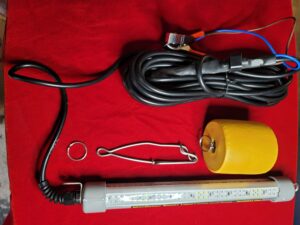Shrimping can be a highly rewarding activity, especially when you have a strategy. One of the key components for a successful shrimping experience is deploying the shrimping light with a strategic deployment light strategy. These lights are used to back light the shrimp which is a form of manipulation to bring them to the top of the water column. This enables you to see them clearly and net them easily. But simply having shrimping lights isn’t enough—you need to set them up correctly to maximize your catch. Not every fishing light can be a shrimping light but every shrimping light can be a fishing light. You need right amount of lumens, vertical orientation, light anchoring system and depth control to be successful. The MacDaddy Fishing Lights™ are Florida’s top selling light for shrimping. It was innovated for this sport.
Why Shrimping Lights Are Important
There are multiple species of shrimp, The common species in Florida are the brown, pink and white shrimp. All 3 of these species can be caught at night. But, the white shrimp specie can also be caught by cast net during the day time in the Fall. The second point is the white shrimp can tolerate light. The brown and pink shrimp, the two most desired night species cannot tolerate light. The Full moon is offensive. How you set your lights will impact how the shrimp or squid respond. Tossing a fishing light into the water without a plan places you at the mercy of luck. Luck cannot be repeated with any form of consistency. Science can be repeated. Deploy your shrimping light using the proven light deployment strategies researched and published by Florida’s recreational shrimping expert, Capt. Lee Noga.
Choosing the Right Type of Shrimping Lights
Before setting up your shrimping lights, it’s essential to pick the right type. There are two main options to consider:
● LED Lights Single Mode: These are energy-efficient, durable, and provide bright light without using too much power. They are either ON or OFF. Purchase a light that gives you the ability to anchor your light, set the light depth & floats vertical (Up/Down) in the water column so that you can manipulate the shrimp using light deployment strategies. The MacDaddy Fishing Lights™ were innovated to parallel the research published by Capt. Lee Noga. This is an entry level light built for science deployment strategies but does not have all the bells and whistles.
● LED Lights Multi-mode:: These shrimping lights have multiple modes that do different things. They are the toolbox of features. The MacDaddy Smart Light® is the first smart fishing shrimping light on the market that comes with an educational program. The modes include 3 strobes and 4 different types of “steady burn” for shallow or deep water. The ultimate shrimping light for target manipulation when used with the science based strategic light deployment strategies.
Step 1: Location
The first thing to consider when setting up shrimping lights is where you’re shrimping. Ideally, you’ll want to set up your lights in areas with higher shrimp populations, which are wind driven waters or tidal waters. Shrimp during the outgoing falling tide and refer to your local tide charts to get the times. In Central Florida we set their lights in 10-15 foot of water in the inter-coastal. If your shrimping to deep there is no reason for the shrimp to move up into upper water column. There are popular structures (old abandoned bridges) people shrimp under that are deeper than 15 foot and require 4 to 6 lights.
Best Places to Set Up Shrimping Lights
● Near drop-offs where the water deepens
● Edges of hidden sand bars
● Wind driven bridge areas
● Tidal water rivers (saltwater) to include shallow cuts
Step 2: Positioning Your Shrimping Lights
Underwater vs. Above Water
There are two main options when positioning your shrimping lights: underwater vs. above water.
● Underwater Lights: Submerged lights are incredibly effective because they do not deter the shrimp coming towards your net if deployed properly. These lights need an anchoring system. You want to set your lights away from your boat. You need to set the perfect depth of your light so the water remains unlit above your light. The vertical set of the light creates a circle of light that does not reach the light surface.
● Above Water Lights: Mounted on boats or docks, these lights shine down onto the water. Light sensitive marine species will dive towards the bottom to avoid the light depending on how powerful the light is. These types of lighting cannot manipulate the shrimp nor encourage the larger targets to ascend to the top of the water for capture.
Step 3: How Many Lights Should You Use?
The art of marine manipulation using light deployment strategies requires 2 lights. Shrimping success means different things among anglers. Some anglers are happy with 1 light when they are by themselves. For 2-3 people, two lights may be sufficient to net the shrimp. The more lights you deploy, the larger your light field. The larger the light field, the more shrimp you will see to net.
Suggested Setup for Different Scenarios
● Single Boat Setup: Set your boat horizontal (east/west) with 2 anchors. Deploy 1 – 2 shrimping lights. In tidal water face South and deploy your lights. You need 2 shrimping lights to manipulate shrimp using light deployment strategies.
● Dock Setup: For deep water you will need a light set at proper depth to push them up and towards you. Shrimping by dock light only is not the greatest strategy.
Step 4: Adjusting Light Brightness and Color
Brightness Levels
The brightness of your shrimping lights is crucial. You don’t want lights that are too dim, as they create a small visual field. On the other hand, extremely bright lights can be overkill and may scare off the shrimp. Aim for a balance; most shrimping lights should have a brightness of around 1800 to 6000 lumens. Note, once the LED light is built the waterproof housing mutes the lumens by 30-40% . Retailers do not disclose this and market the power of the LED strip before the light was assembled. Remember shrimping lights are offensive to the various marine life that thrive at night vs. the daytime. How you set the light will determine your success not the number of lumens the retailer markets.

Light Color Considerations
The popular fishing lights for shrimping are the combination of both white and green LEDs. Green has proven to cause less eye fatigue compared to the white. The MacDaddy fishing lights™ creates the soothing green glow. The magic was adding a lower lumen white strip in combination to give you more visual depth ( included in all models). The MacDaddy Smart Light® gives you 7 to 8 modes which allows you to use both colors, single color, half power and 3 strobes designed to give you several advantages. The typical ON/OFF fishing light is just a tool for entry level options. A multi-mode light gives you a toolbox. Tidal water can be crystal clear or really dirty so having a toolbox allows you to amp up light or temper it down when needed.
Step 5: Timing Is Everything
Timing your shrimping trip with the right moon conditions is essential for success. The desired shrimp species move during the outgoing tide at night, making it the best time to set up your lights. The tide chart is important. The falling tide is the time frame in which you have to net the shrimp. The first hour of incoming tide can be lucrative during the peak and end of season. The shrimp tend to be smaller.
Best Times for Shrimping
● Dusk: As the sun sets and daylight begins to fade, shrimp become more active, making this an ideal time to start setting up your lights.
● Night: Opportunity is during the outgoing tide time frames. Short tide is a short night.
● Tide Phases: Plan your trip around high tide or just after the tide has started to recede. The best time to go is at the change of tide (the last of the incoming tide).
Step 6: Securing Your Lights for Safety
Whether you’re using a boat or dock, it’s crucial to ensure that your lights are securely fastened. It is easy to accidentally catch the shrimp light cord and detach the light from the battery. This could result in the loss of your light. If using a boat, make sure underwater lights are cable tied to the battery or some object/cleat to keep them from going overboard.
Step 7: Powering Your Shrimping Lights
Your shrimping lights will need a reliable power source to stay illuminated throughout your fishing trip. There are a few options to consider:
Battery-Powered Lights
Battery-powered 12v lights are portable and great for dock or small boat setups. Shrimping Lights under 6000 lumens (total) can use a 675 crank amps battery to power 2 lights.
Higher lumen lights like the MacDaddy fishing lights™ ULTRA series require a 1000 crank amp battery (car battery) to power 2 lights. These are the 6000 lumen lights pre-build.
Generator-Powered Lights
Generators offer more consistent power and can run multiple lights for an extended period. They are ideal for larger setups but can be noisy, which might disturb the tranquility of shrimping. These were popular 20 years ago and phased out by technology. We do not recommend them.
Step 8: Testing and Adjusting the Setup
Before you begin shrimping, it’s essential to test your light setup. Ensure that the lights are positioned correctly, the light field brightness is balanced, and the power source is reliable. Adjust the placement of the lights if necessary to ensure you’re manipulating as many shrimp as possible. Remember the lights get brighter as the water levels lower during outgoing tide. Set your lights as low as possible but still able to see targets.
Common Adjustments
● If you’re not seeing any shrimp after some time, try setting your lights to a different depth or location.
● If the lights are too bright, set them deeper
Step 9: Using the Right Net for Shrimping
Once your lights are set up and the sun has set the shrimp will begin moving. Using the right net is just as important as your lighting. A dip net (used at night) or cast net (used during the day) is typically used for shrimping, depending on the depth of the water and your shrimping location. Best shrimping dip net has a 3/8 inch mesh bag. Bring 4 inch cable ties to cinch up any rips and tears to prevent shrimp from escaping.
Conclusion
Setting up shrimping lights correctly can make all the difference in your night shrimping adventures. By choosing the right type of lights, positioning them effectively, and adjusting brightness and color, you can create an efficient setup that steers the shrimp right to you. Remember, it’s all about science & strategies—don’t be afraid to adjust your lights or location if needed. Capt Lee Noga has spend her career educating anglers how to shrimp and be be productive consistently. For more extensive detail download the educational training materials for more information.
